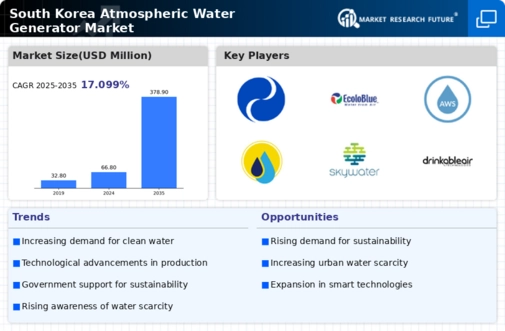The atmospheric water-generator market in South Korea is characterized by a dynamic competitive landscape, driven by increasing demand for sustainable water solutions and technological advancements. Key players such as Watergen (IL), Skywater (US), and Zero Mass Water (US) are at the forefront, each adopting distinct strategies to enhance their market presence. Watergen (IL) focuses on innovation, particularly in developing energy-efficient systems that utilize ambient air to produce potable water. Meanwhile, Skywater (US) emphasizes regional expansion, targeting areas with acute water scarcity, thereby positioning itself as a critical player in emergency response scenarios. Zero Mass Water (US) leverages partnerships with local governments and NGOs to promote its solar-powered hydropanels, which align with sustainability goals and community engagement initiatives. Collectively, these strategies contribute to a competitive environment that prioritizes technological innovation and regional responsiveness.
In terms of business tactics, companies are increasingly localizing manufacturing to reduce costs and enhance supply chain efficiency. This approach appears to be particularly relevant in South Korea, where the market structure is moderately fragmented, with several players vying for market share. The collective influence of these key players fosters a competitive atmosphere that encourages continuous improvement and adaptation to local needs, thereby enhancing overall market resilience.
In October 2025, Watergen (IL) announced a partnership with a South Korean technology firm to develop a new line of atmospheric water generators tailored for urban environments. This strategic move is significant as it not only expands Watergen's product offerings but also enhances its ability to cater to the specific needs of densely populated areas, where water scarcity is becoming increasingly pressing. The collaboration is expected to leverage local expertise, thereby accelerating product development and market penetration.
In September 2025, Skywater (US) launched a pilot program in collaboration with a South Korean municipality to deploy its atmospheric water generators in public facilities. This initiative is crucial as it demonstrates Skywater's commitment to addressing local water challenges while simultaneously showcasing the effectiveness of its technology in real-world applications. The pilot program is likely to serve as a model for future projects, potentially leading to broader adoption across the region.
In August 2025, Zero Mass Water (US) secured a grant from a South Korean environmental agency to expand its hydropanel installations in rural areas. This funding is pivotal as it not only supports the company's growth strategy but also aligns with governmental efforts to promote sustainable water solutions. The grant underscores the increasing recognition of the importance of innovative water generation technologies in addressing water scarcity issues, particularly in underserved communities.
As of November 2025, current competitive trends in the atmospheric water-generator market are heavily influenced by digitalization, sustainability, and the integration of AI technologies. Strategic alliances are becoming increasingly vital, as companies seek to enhance their technological capabilities and market reach. The competitive differentiation is likely to evolve from traditional price-based competition towards a focus on innovation, technological advancements, and supply chain reliability. This shift suggests that companies that prioritize these aspects will be better positioned to thrive in an increasingly competitive landscape.





















Leave a Comment